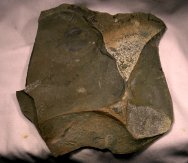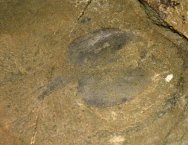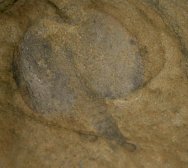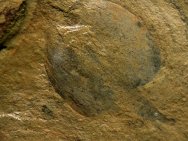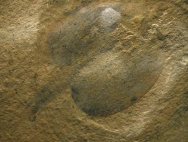Canadaspis
perfecta
Phylum Arthropoda
(Euarthropoda), Class Malacostraca, Subclass Phyllocarida, Order Canadaspidida,
Family Canadaspididae
Geological
Time: Early Middle Cambrian, (~525 million years ago)
Size: Fossil
carapace 30 mm long by 30 mm across
Fossil
Site: Comet Shale Member, Pioche Formation, Lincoln County, Nevada
| 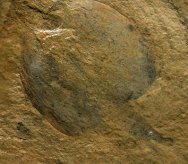 Description:
This unusual fossil is an example of a rarely-seen Phyllocarid known
as Canadaspis perfecta. It is a bivalved crustacean, and comes from
the Comet Shale Member of the Pioche Formation of Nevada. This deposit Description:
This unusual fossil is an example of a rarely-seen Phyllocarid known
as Canadaspis perfecta. It is a bivalved crustacean, and comes from
the Comet Shale Member of the Pioche Formation of Nevada. This deposit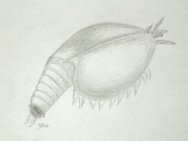 spans the transition of Early to Middle Cambrian which saw the extinction
of the Olenellid trilobites. It is just younger than the comparable
material from the Chengjiana Biota of Yunnan Province, China and
just older than the Burgess Shale Fauna of British Columbia, Canada.
The species is also known from the Burgess Shale and from Early/Middle
Cambrian deposits of Utah. A related species, Canadaspis laevigata
is found in the Chengjiang deposits of China. Few examples of the
genus are known from more than the carapace, so the preserved segmented
abdomen seen here is quite rare.
spans the transition of Early to Middle Cambrian which saw the extinction
of the Olenellid trilobites. It is just younger than the comparable
material from the Chengjiana Biota of Yunnan Province, China and
just older than the Burgess Shale Fauna of British Columbia, Canada.
The species is also known from the Burgess Shale and from Early/Middle
Cambrian deposits of Utah. A related species, Canadaspis laevigata
is found in the Chengjiang deposits of China. Few examples of the
genus are known from more than the carapace, so the preserved segmented
abdomen seen here is quite rare.
|
|


